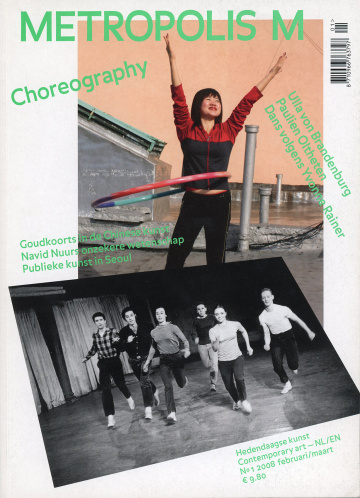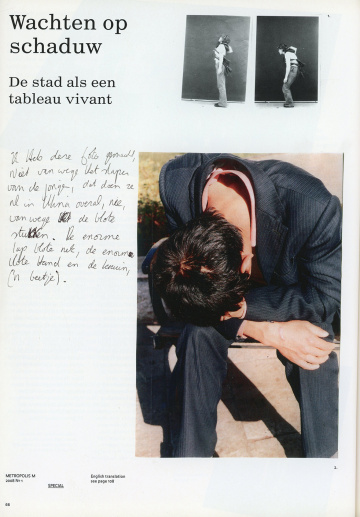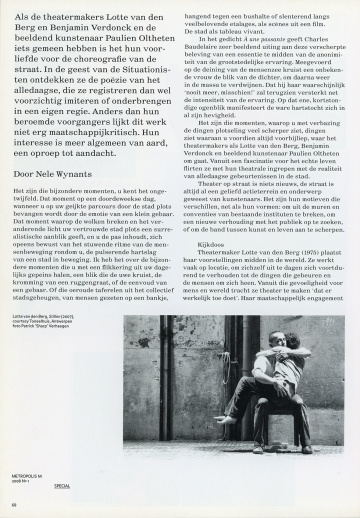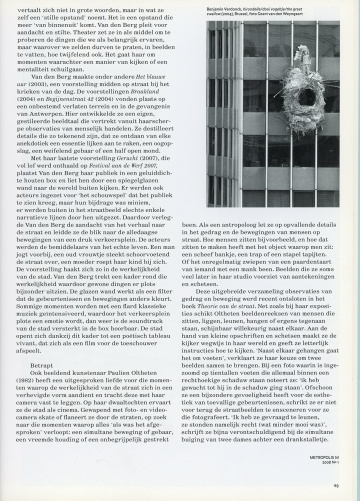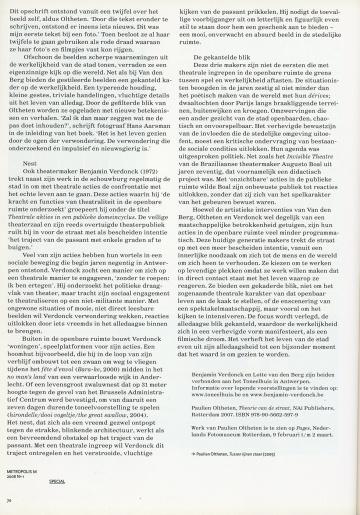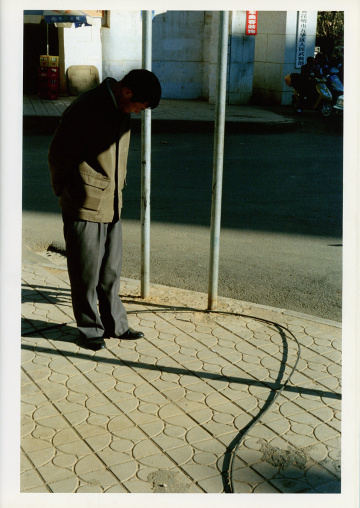Essay by Nele Wynants
If theatre-makers Lotte van den Berg and Benjamin Verdonck and visual artist Paulien Oltheten have something in common, it is their partiality to street choreography. In the spirit of the Situationists, they discover the poetry of everyday life, which they record and circumspectly imitate or incorporate in a direction of their own. Unlike that of their famous predecessors, this work does not seem inclined to social criticism. Their interest is more general in nature, a call to attention.
Those extraordinary moments: you undoubtedly know them. That moment on a day of the week like any other when, moving along your familiar trajectory through the city, you are suddenly gripped by the emotion of a minute gesture, the brief instant when the clouds break and the altered light suddenly gives the city a surrealistic appearance. You stop in your tracks, all at once aware of the driving rhythm of human movement around you, the beating heart of a city in motion. I am speaking of the unusual moments when something flickers, bringing you out of your everyday musings: an expression crossing your eye, the curve of a spine, or the simplicity of a gesture. It could be an ancient scene from the collective memory of the city, of people sitting on a bench, leaning against the side of a bus stop or ambling along store window displays filled with promise, like scenes from a film: the city as a tableau vivant.
In the poem À une passante, Charles Baudelaire very graphically expressed this heightened experience of something essential in the midst of the anonymity of the experience of a major city. Carried on the swell of a sea of humanity, the gaze of an unknown woman meets that of the poet, only to disappear in the crowd again. That he will see her ‘perhaps, never again!’ reinforces the intensity of the experience. In that single, fleeting moment, true passion has manifested itself in all its force.
The moments in which you are suddenly surprised to see everything much more sharply, to see things you had hitherto always just passed by, are what the work of theatre-makers Lotte van den Berg, Benjamin Verdonck and artist Paulien Oltheten is all about. From the perspective of their fascination for real life, they use theatrical interventions to flirt with everyday urban events.
Theatre in the streets is nothing new. The street has always been a favourite arena and subject matter for artists. What differs here are the motivations, as well as the forms: these artists break out of the walls and conventions of existing institutions to seek new relationships with their audiences or to sharpen the bonds between art and life.
Looking Box
Theatre-maker Lotte van den Berg (born in 1975) places her performances in the middle of the world. She often works on location, challenging herself to constantly relate to the things that are happening and the people around her. From this sensitivity to people and to the world, she attempts to create theatre ‘that is really relevant’. She does not translate her social engagement into big words, but into what she refers to as a ‘silent rebellion’. It is a rebellion that comes more ‘from inside out’. Van den Berg’s plea is for attention and for silence. She employs theatre as a means of testing the things that we experience as important, but about which we seldom dare speak or incorporate in images, however hesitatingly. Her concern is for the moments that conceal and reveal a way of looking or a way of thinking.
Van den Berg’s works include Het blauwe uur (2003), a performance held literally in the middle of the street at the first sign of daylight. In 2004, Braakland (2004) and Begijnenstraat 42 (2004) were held on a vacant lot and at the Antwerp penitentiary, respectively. Here, she had developed her own, distilled visual language based on razor-sharp observations of human activity. Van den Berg distils details that become so poignant that, stripped of everything anecdotal, they seem to touch an essence: the lifting of an eye, a hesitating gesture or a half-open mouth.
With her most recent performance, Gerucht (2007), which was lavished with praise at the Festival aan de Werf 2007, Van den Berg put her audience in a soundproofed wooden box and let them look out onto the world through a wall made of mirrored glass. Actors were used for ‘the spectacle’ that was presented to the audience, but their contribution was only minimal. Outside, in the scene on the street, they defined only a few summary narrative lines. Van den Berg thus shifted the concentration of the story to the street itself, guiding the focus to the everyday activity at a busy intersection. The actors became mediators of real life. A man jogs past. An old woman reluctantly crosses the street. A mother calls her child to her side.
The ‘performance’ cuts into the reality of the city. Van den Berg draws a frame around that reality, causing extremely ordinary things to suddenly look very exceptional. The glass wall works like a filter, changing the colour of events and movements. Some moments are made more intense by a fragment of classical music, so that the intersection suddenly becomes an emotion. Or later, the soundtrack of the city itself is heard, amplified, in the box. Through this frame, the city opens into a poetic tableau vivant playing for the audience as if in a film.
Trapped
Artist Paulien Oltheten (b. 1982) also has a pronounced love of those moments when the reality of the street presents itself in intensified form. She attempts to record this with her camera. Rambling through the city, she experiences it as cinema. Armed with still and video cameras, she walks or skates through the streets in search of those moments when everything happens ‘as if it were pre-arranged’: simultaneous movements or gestures, a strange posture or a leg extended in incomprehensible fashion. As an anthropologist might, she concentrates on conspicuous details in the behaviour and the movements of people on the street, how they sit, for example, and how that sitting has to do with the object on which one is seated, be it a crooked little bench, a step or a pile of carpets. It might be a regular swishing of the ponytail of someone with a crippled leg. These are images that she completes in her studio – sometimes much later – with notes and sketches.
Pauline Oltheten’s extensive collection of observations of behaviour and movements has recently been compiled in her book, Theorie van de straat. As in her exhibitions, she here organized series of images in which people sit, lie, and lean, hang or stand against something, in seemingly random juxtapositions. With the further help of brief notes and sketches, she provides us with a guide to her world, literally giving instructions on how to look. ‘Hanging next to each other; it is all about feet’, is one explanation for putting two images together. Next to a
photograph zoomed in on dozens of feet, all standing in a right-angled shadow, she noted, ‘I waited until he went and stood in the shadow.’
Although Oltheten is exceptionally responsive to the aesthetics of coincidental events, she does not shy away from staging street scenes before photographing them. ‘I asked them to lean over a bit. They were standing straight, which was less beautiful,’ she wrote, almost by way of excuse for the simultaneous bending over of two women behind a soda stall. The comment arose from doubts about the image, explains Oltheten. ‘By putting the text beneath the image, something new suddenly emerges. That was my first text to accompany a photograph.’ She then decided to make use of all her doubts in the form of a consistent thread by which she could lace together her photographs and films.
Although the images are keen perceptions of the reality of the city, they reveal a unique view of that world. As is also true for Lotte van den Berg, Pauline Oltheten’s distilled images offer reality in a tilted frame – a characteristic posture, small gestures, trivial actions, fleeting details from commonplace living. Through Oltheten’s filtered vision, they become laden with new meanings and narratives. ‘Shall I just say what makes me hesitate as I’m taking a step?’ wrote photographer Hans Aarsman in his introduction to Theorie van de straat. ‘It is seeing life through the eyes of wonderment, the wonderment that investigates, but is both impulsive and curious.’
Nest
In addition to his work in regular theatres, Benjamin Verdonck (b. 1972) regularly goes into the city itself to confront real life with theatrical actions. He groups these happenings, in which he ‘investigates the strength and the functions of theatricality in public space’, under the title Cyclus of Theatrical Actions in a Public Domain. Verdonck exchanges the comfortable context of the theatre and its pre-convinced audience for the street with the humble intention of ‘bending the trajectory of the passer-by by a few degrees’.
Many of Verdonck’s actions are rooted in a social movement that evolved in Antwerp in the early 1990s. Verdonck sought a way to engage himself in a theatrical manner, ‘without crying out, “I am against it”’. He investigates theatre’s political support base, but tries to make his engagement theatrical in a non-militant fashion. With unusual situations or with beautiful, not immediately decipherable images, Verdonck wants to elicit wonderment and generate reactions by inserting something strange into the everyday.
Outdoors, in public space, Verdonck builds ‘homes’ as stages for his actions. During the time he lived in a tree house in the middle of a no-man’s-land in a dilapidated neighbourhood in Anderlecht, for example, he rebuilt it into a swan, on which he could fly away during the fête d’envol (Bara-ke, 2000). He also built a big-as-life swallows’ nest, 31 metres in the air, against the façade of the Brussels Administrative Centre, to use as a base for a seven-day theatrical performance (hirondelle/dooi vogeltje/The Great Swallow, 2004). The nest, swelling out like a strange growth against the taut, shining architecture, had the effect of an alienating obstacle in the path of passers-by. By using theatrical intervention, Benjamin Verdonck wants to destabilize this trajectory and stimulate an absent-minded, fleeting look from passers-by. He invites the coincidental passer-by to take pause, literally and figuratively, by offering a gift: a beautiful, unexpected and absurd image in urban space.
Tilted Perspective
These three artists are not the first to have used theatrical interventions in public space to explore the frontier that divides theatre and reality. In the 1960s, the Situationists aimed for nothing less than making the world a poetic place with their dérives, or meanderings through Paris along abandoned plots, forgotten neighbourhoods and cafés; urban journeys revealing a different, chaotic and unpredictable face of the city. Heightened awareness of influences that exert themselves on a city’s environment was intended to elicit a critical examination of social conditions. Their agenda was explicitly political, as was that of the Invisible Theatre of the 1970s by the Brazilian theatrical director and writer, Augusto Boal, which was primarily a didactic project. With ‘invisible’ actions in public space, Boal wanted to elicit reactions from an unaware audience, without their becoming conscious of the theatrical nature of the event.
Although the artistic interventions of Lotte van den Berg, Paulien Oltheten and Benjamin Verdonck are evidence of social engagement, their actions in public space are far less programmatic. The current generation of creators of theatre go out into the streets with more humble intentions, from an inner need to relate to the people and the world around them. They choose to work in lively locations because they want to produce work in direct contact with the life to which they are responding. They give us a framed perspective, not in order to point out the so-called theatrical character of that public life or the staging of a society of spectacle, but to intensify the act of looking. The focus is shifted, the commonplace glance set off kilter, by which reality manifests itself in heightened form, as if in a cinematic dream. It briefly raises the life of a city out of its mundanity, into an exceptional moment that is indeed worth seeing.
Nele Wynants
Both Benjamin Verdonck and Lotte van den Berg are associated with the Antwerp Toneelhuis. Information on current performances and exhibitions is available at www.toneelhuis.be and www.benjaminverdonck. be
Paulien Oltheten, Theorie van de straat, NAi Publishers, Rotterdam 2007 ISBN 978-90-5662-597-9
Work of Paulien Oltheten is on show at Pages, Nederlands Fotomuseum, Rotterdam 9 February - 2 March
